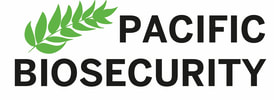|
Niue Department of Environment staff with a fungus-affected fallen tree in Huvalu Conservation Area.
|
April 2023
PRISMSS partner collaboration helps Niue decision-making to rapidly respond to an invasive species outbreak Landowners in Niue had reported seeing dying trees and a fungus in the Huvalu Conservation Area. Huggard Tongatule, Niue’s National Invasive Species Coordinator, mentioned this problem to the PRISMSS NENS team from Manaaki Whenua while they were visiting to survey the forests. The Manaaki Whenua team ran a rapid drone survey to see what proportion of trees were affected, which was much faster than a survey on the ground. The team also took samples for identification. Back in New Zealand, the identification came back quickly. It was Pyrrhoderma noxium (formerly Phellinus noxius), a fungus that causes brown root rot and is well known to kill patches of trees in the northern Pacific islands region. More than 200 species of tropical trees are susceptible to the fungus. Manaaki Whenua have an accession of the fungus from Niue dating back to 1965, so it could have been present, but not causing obvious symptoms, for decades. SPREP’s RERC/WOW lead contacted Phil Cannon, the regional expert on this fungus, for advice. Phil shared a book he wrote on the fungus. By coincidence, Phil happened to be in the Marshall Islands at the same time as POI lead Pacific Biosecurity. Phil shared detailed advice on the biology and ecology of the fungus, especially how it spreads, and potential management options that Niue could consider. The information that PRISMSS partners and colleagues gathered enabled Niue to consider decisions on the best approach, and to set a plan in place. Having that fundamental information quickly was crucial for timely decision-making. Huggard recommends drone surveys for other countries facing these types of questions, so they can more quickly assess the extent of these potential problems, which would take a huge effort otherwise. As Huggard said, “This was a great example of the PRISMSS partners working together to quickly act on a problem that in the past might have taken years to resolve”. Finding the right information for countries for informed decision-making is just one of the services PRISMSS can offer the region. Thanks to everyone who took part in this work, including Huggard Tongatule, Samalae Siligi, Ireena Mautama, Terence Lakatani, Wayne Kifoto, Paul Petersen, Temo Talie, Alana Den Breeyen, Lynley Hayes, Greg Sherley, Phil Cannon, David Moverley, Monica Gruber |
|
August 2022
A Customs Broker in Tonga finds a Giant African Snail (GAS) at Tongatapu’s main seaport Siutoni Tupou, Head of MAFF-Quarantine Division for the Kingdom of Tonga, describes how her team dealt with the recent incursion of Giant African Snail. “On Friday morning 26 August 2022, a Customs Broker found one snail on the doorstep of the Customs Office. On the same day, our Quarantine Inspectors scattered some Blitzem snail bait around the Customs compound and the next day, Blitzem was applied to the main port of Queen Salote wharf and imported container yards. The Quarantine Inspectors monitored and scouted for more snails three times over the following six weeks. To date, no further snails have been found, but daily radio announcements call for the public to report any more sightings.” Siutoni’s team’s experience highlights how effective awareness is to help prevent the establishment of new species, and how other government workers can support the work of the biosecurity/quarantine teams. The speedy action by Tonga’s Quarantine team eliminated the risk of the snails travelling from the port to other island groups. Giant African Snail is a priority species for prevention in the region. The snail can devastate all types of crops and carries a rat lungworm parasite that can cause a brain inflammation in people. It damages native plants, altering the natural habitats needed by native species. It also probably outcompetes native snails, which are a group that is threatened by invasive species in many Pacific countries. |




